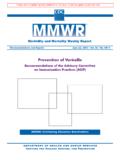Transcription of Unit 3 - Jones & Bartlett Learning
1 unit 3 Answeringthe ResearchQuestion:QuantitativeDesignsbroc kopp06 7/30/02 11:39 AM Page 191192 Intentional Blankbrockopp06 7/30/02 11:39 AM Page 1926 MeasurementGoals Analyze the levels of measurement. Describe the key concepts related tomeasurement. Describe knowledge necessary to evaluate adequately the use goal of research is to provide accurate answers toquestions of interest. Questions of interest within nurs-ing are developed from nursing concepts, namely, thosethoughts, notions, or ideas that relate to nursing or nursingpractice. Nursing concepts are then translated into observablefacts or events. Translating a nursing concept into an observ-able fact or event permits the investigator to measure theevent(s) of interest. The key word in relation to measurementis accuracy. The selection of a method of sampling influencesthe degree to which findings can be generalized; the measure-ment process influences the degree of accuracy of the results.
2 Brockopp06 7/30/02 11:39 AM Page 193 Chapter 6 Measurement194 Concerns related to measurement include the following:1. What level of measurement is used (nominal, ordinal, interval , ratio)?2. What strategy is used to measure the variables understudy (paper-and-pencil questionnaire, interview, etc.)?3. To what degree can a measurement strategy provide accu-rate information (reliability, validity, normative data)?4. What factors related to data collection enhance or dimin-ish the accuracy of the results?5. Given the measurement strategies used in a particularstudy, what methods of data analysis are most likely toprovide accurate information?This chapter deals with each of these concerns and discussesthe importance of appraising the literature from a measure-ment perspective. Measuring VariablesThe number of variables appropriate for examination by nursesis almost limitless. Any of the physiological and psychosocialconcepts that are a part of nursing practice are open to system-atic examination.
3 Specific variables that may be identified innursing research can include age, sex, measures of pain, bloodpressure readings, a psychological attribute such as perceptionof control, and others too numerous to mention (see ). Although a major focus of nursing research at present isthe development of a scientific body of knowledge as the under-pinnings for practice, in nursing as a whole there is tremendousdiversity among the variables appropriate for of the variables under study, in order to makesense out of the data collected, each variable must be measuredin such a way that its magnitude or quantity can be clearlyidentified. A variety of measurement methods are available foruse in nursing research. The specific strategies chosen dependbrockopp06 7/30/02 11:39 AM Page 194 Measuring Variables195 AgeSexBloodpressurereadingControlPainFIG URE related to nursingon the particular research question, the sample under study,the availability of instruments, and the general feasibility ofthe project.
4 One measurement strategy is not necessarily betterthan another. Four scales or levels of measurement have beenidentified: nominal, ordinal, interval , or ratio. Each level ofmeasurement is classified in relation to certain investigators data fall within the first level of measure-ment, the range of choice relative to statistical analysis is lim-ited. Data that fall within the fourth level of measurement canbe analyzed using a broad array of statistical 7/30/02 11:39 AM Page 195 Chapter 6 Measurement196 MaleUnderage 20 Bloodtype ASickFIGURE nominal level of measurement: Discrete categoriesThe Nominal Level of MeasurementThe first or nominallevel of measurement is characterized byvariables that are discrete and noncontinuous. These variablesare categorical and include such examples as sex (male,female), marital status (married, unmarried), blood types (0,A, B, AB), and health state (sick, well). Examples are shown inFigure commonly used to denote this level of measure-ment include nominal scale, categorical data, nominal data,and nominal measurement.
5 In each instance the expressiondescribes categories that are discrete, named, and thereforemutually definitionThe Nominal Level of MeasurementThe nominal level of measurement is the most primitivemethod of classifying information. Nominal replies that cate-gories of people, events, and other phenomena are named, areexhaustive in nature, and are mutually exclusive. These cate-gories are discrete and 7/30/02 11:39 AM Page 196 Measuring Variables197exampleThe Nominal Level of MeasurementA nurse researcher investigated the effects of an educationalpackage dealing with diabetes on the teenage diabetic s com-pliance with dietary restrictions. The following data were col-lected three months after the educational presentation:Exposure to educational , N= 38 Good, N= 15 Poor, N= 23 Females, N= 27 Good, N= 18 Poor, N= 9 To analyze the data, the researcher used a method of statisti-cal analysis appropriate to the nominal level of measurement(chi-square).
6 In this example compliance is measured in a discrete fash-ion; that is, the participants were either compliers or non-compliers. A focus of the research was on sexual differ-ences, males versus females. The nominal level ofmeasurement implies that there are named categories forexample, male, female; that the categories are mutuallyexclusive for example, male female, compliers noncom-pliers; and that the categories are not ordered in any fash-ion. There are not, for example, degrees of maleness orfemaleness, nor are there degrees of compliance, as definedin this choice of the appropriate statistical method with whichto analyze data is a crucial factor in the eventual worth of theresearch project. When a nominal level of measurement hasbeen used, the choice of statistical methods that will providemeaningful results is 7/30/02 11:39 AM Page 197 Chapter 6 Measurement198practiceIdentifying Nominal VariablesFrom the following research questions, identify those variablesthat are most likely to be measured using a nominal scale: What is the relationship between gender and the incidenceof diabetes?
7 Variables:Gender, incidence of diabetes How does paying a shift differential affect absenteeismamong nurses on a critical care unit ? Variables:Shift differential, absenteeism How do age and sex affect compliance in a cardiac rehabili-tation program? Variables:Age, sex, compliancecritical appraisalThe Nominal Level of MeasurementIf a nominal level of measurement is used, does it seem appro-priate given the topic under study?The Ordinal Level of MeasurementThe second or ordinallevel of measurement is characterized byvariables that are assessed incrementally. For example, paincan be measured as slight, moderate, or intense. Exercise canbe measured in terms of frequency that is, often, sometimes,or never. In each case, there are increments or intervals in thescale, but these intervals cannot be considered equal (see Fig-ure ).As with the nominal variable, it is not some innate value ofthe specific variable that causes it to be ordinal, but the man-ner in which it is measured.
8 Pain or exercise could be meas-brockopp06 7/30/02 11:39 AM Page 198 Measuring Variables199 Pain:SlightModerateIntenseAnxietyexperie nced:FrequentlyOccasionallyRarelyBonding :AbsentMinimalModerateStrongFIGURE ordinal level of measurement: Continuous variables, incre-ments not of equal value; variables can be rank-ordered from highest to lowestured using a scale that denotes equal intervals. Exercise couldbe assessed in terms of the number of miles run or the amountof weight commonly used to denote this kind of measure-ment includeordinal scale,ordinal variables,ordinal data,andordinal measurement. Unlike the nominal level of meas-urement, the ordinal level of measurement suggests an order-ing of variables. Within the ordinal level of measurement, anevent is assigned to a category based on the amount of a par-ticular attribute. This level of measurement can be describedas the ranking of events in terms of the relative amounts of aspecified characteristic.
9 Pain can be ordered or ranked interms of the intensity of the experience namely, intense,moderate, or mild thus reflecting an ordinal approach. Sex isusually perceived as male or female without an ordering ofsexual characteristics, thus reflecting the nominal level 7/30/02 11:39 AM Page 199 Chapter 6 Measurement200working definitionThe Ordinal Level of MeasurementThe ordinal level of measurement is second in terms of itsrefinement as a means of classifying information. Ordinalimplies that the values of variables can be rank-ordered fromhighest to Ordinal Level of MeasurementA team of nurse researchers designed a research project tocompare the degree of social support (SS) perceived by 100teenage girls diagnosed as bulimics with a group of nonbulimicgirls of the same age, educational level, family size, and place-ment within the family. Each participant responded to a paper-and-pencil test.
10 The following data were collected:Considerable SSModerate SSLittle SSBulimics133057 Nonbulimics355510To analyze the data, the researcher used a method of statistical analysis appropriate tothe ordinal level of measurement (chi-square).In this example, the variable of social support is rank-ordered. Some participants felt that they had considerablesocial support; others had moderate social support; and stillothers had little social support. Even though social support ismeasured in an incremental fashion (considerable, moderate,little), a consistent number cannot be associated with the dis-tance between considerable, moderate, and little. The data col-Cbrockopp06 7/30/02 11:39 AM Page 200 Measuring Variables201lected, therefore, are ordinal and are somewhat limited in rela-tion to the statistical techniques available for data Ordinal VariablesHow could the following variables be measured at the ordi-nal level?Example:Pain using a scale that measures pain as absent,moderate, strong, or :Depression, skin turgor, helplessness, grief, stress,confusion, appraisalThe Ordinal Level of MeasurementIf an ordinal level of measurement is used, does it seem appro-priate given the topic under study?















